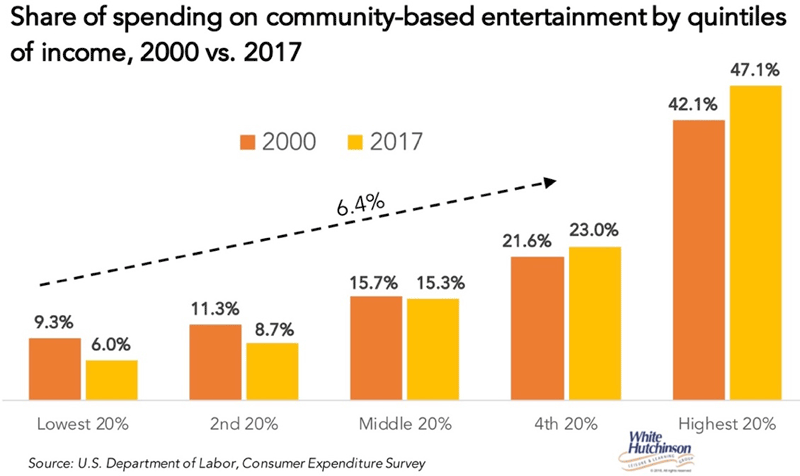
Vol. XIX, No. 2, February 2019
- Editor's corner
- Two of our continuous long-term clients
- The first Instagram food photos
- What's old is still relevant
- North American movie theater attendance trends
- Committed consumption impacting out-of-home entertainment
- Rise in visits to non-traditional experiential food & beverage venues
- Gentrification of out-of-home entertainment
- The mindful low- and no-alcoholic trend
- Changes in educational attainment
Gentrification of out-of-home entertainment
Since the turn of the century, lower income households have been spending less on community-based entertainment while higher income households have increased their spending. As a result, there's been a gentrification, a greater share of community-based entertainment spending has shifted to higher income households, with most shifting to the top 20% of households by income. The top 20% of households by income ($110,000+ incomes) now account for almost half of all community-based entertainment spending. The top 40% now account for 70% ($67,000+ incomes).

There's no reason these trends won't continue to accelerate in 2019 and beyond. These aren't passing fads or trends as their roots are deeply planted in shifting cultural behaviors and structural changes in our economy.
What this means is that for a CLV to be successful today and into the future, it needs to target the upper-middle- and higher-income households. Many predominately middle-class markets that might have been viable locations a number of years ago are no longer feasible markets for CLVs.
Vol. XIX, No. 2, February 2019
- Editor's corner
- Two of our continuous long-term clients
- The first Instagram food photos
- What's old is still relevant
- North American movie theater attendance trends
- Committed consumption impacting out-of-home entertainment
- Rise in visits to non-traditional experiential food & beverage venues
- Gentrification of out-of-home entertainment
- The mindful low- and no-alcoholic trend
- Changes in educational attainment


